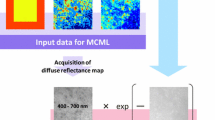Abstract
Analysis of concentration of components in skin tissue, such as melanin, blood, oxygen saturation, is important in medical or cosmetic fields. Some researchers have developed methods to estimate the components. However, almost all the research has not considered a depth dependency of blood concentration and oxygen saturation, which is actual characteristic of skin tissue. Although there has been a method considering the depth dependency, the method does not have capability to estimate oxygen saturation. In addition, there is a problem in the methods that it is possible that the estimation is disturbed by shading which is on skin surface. Therefore, in this paper, we propose a method solving those problems of the methods, that is to estimate melanin concentration, blood concentration, and oxygen saturation in skin tissue layers with independence of shading considering the depth dependency. The proposed method is evaluated on the estimation accuracy with simulation comparing previous methods. The result indicates preferred capability of the proposed method.









Similar content being viewed by others
References
Dwyer PJ, Anderson RR, DiMarzio CA (1997) Mapping blood oxygen saturation using a multispectral imaging system. Biomed Sens Imaging Track Technol II Int Soc Opt Photon 2976:270–280
Tsumura N, Ojima N, Sato K, Shiraishi M, Shimizu H, Nabeshima H, Akazaki S, Hori K, Miyake Y (2003) Image-based skin color and texture analysis/synthesis by extracting hemoglobin and melanin information in the skin. ACM Transac Graph 22(3):770–779
Kikuchi K, Masuda Y, Hirao T (2013) Imaging of hemoglobin oxygen saturation ratio in the face by spectral camera and its application to evaluate dark circles. Skin Res Technol 19:499–507
Shimada M, Masuda Y, Yamada MY, Itoh M, Takahashi M, Yatagai T (2000) Explanation of human skin color by multiple linear regression analysis based on the modified Lambert–Beer law. Opt Rev 7(4):348–352
Nishidate I, Maeda T, Niizeki K, Aizu Y (2013) Estimation of melanin and hemoglobin using spectral reflectance images reconstructed from a digital RGB image by the Wiener estimation method. Sensors 13:7902–7951
Kobayashi M, Ito Y, Sakauchi N, Oda I, Konishi I, Tsunazawa Y (2001) Analysis of nonlinear relation for skin hemoglobin imaging. Opt Soc Am 9(13):802–812
Akaho R, Hirose M, Tsumura N (2018) Evaluation of the robustness of estimating five components from a skin spectral image. Opt Rev 25(2):181–189
Iuchi K, Akaho R, Igarashi T, Ojima N, Tsumura N (2019) Estimation of blood concentrations in skin layers with different depths. In: 27th color and imaging conference, society for imaging science and technology, vol 1, pp 290–294
Wang L, Jacques S, Zheng L (1995) MCML—Monte Carlo modeling of light transport in multi-layered tissues. Comput Methods Progr Biomed 70(2):179–186
Meglinski IV, Matcher SJ (2003) Computer simulation of the skin reflectance spectra. Comput Methods Progr Biomed 70(2):179–186
Meglinski IV, Matcher SJ (2002) Quantitative assessment of skin layers absorption and skin reflectance spectra simulation in the visible and near-infrared spectral regions. Physiol Meas 23:741–753
Gemert MJCV, Jacques SL, Sterenborg HJCM, Star WM (1989) Skin optics. IEEE Trans Biomed Eng 36(12):1146–1154
Svaasand LO, Norvang LT, Fiskerstrand EJ, Stopps EKS, Berns MW, Nelson JS (1995) Tissue parameters determining the visual appearance of normal skin and port-wine stains. Lasers Med Sci 10:55–65
Donner C, Jensen HW (2006) A spectral BSSRDF for shading human skin. In: Eurographics symposium on rendering, pp 409–417
Tsumura N, Kawabuchi M, Haneishi H, Miyake Y (2001) Mapping pigmentation in human skin from a multi-channel visible spectrum image by inverse optical scattering technique. J Imaging Sci Technol 45(5):444–450
Flynn CO, McCormack BAO (2009) A three-layer model of skin and its application in simulation wrinkling. Comput Methods Biomech Biomed Eng 12(2):125–134
Zhang R, Verkruysse W, Choi B, Viator JA, Jung B, Svaasand LO, Aquilar G, Nelson JS (2005) Determination of human skin optical properties from spectrophotometric measurements based on optimization by genetic algorithms. J Biomed Opt 10(2):024030
Ojima N, Minami T, Kawai M (1997), Transmittance measurement of cosmetic layer applied on skin by using processing. In: Proceeding of the 3rd scientific conference of the Asia Societies of Cosmetic Scientists, vol 114
Author information
Authors and Affiliations
Corresponding author
Additional information
Publisher's Note
Springer Nature remains neutral with regard to jurisdictional claims in published maps and institutional affiliations.
About this article
Cite this article
Iuchi, K., Igarashi, T., Ojima, N. et al. Spectral-based estimation of components concentration in skin tissue layers with independence of shading via optical modeling of skin tissue. Artif Life Robotics 27, 9–18 (2022). https://doi.org/10.1007/s10015-021-00727-6
Received:
Accepted:
Published:
Issue Date:
DOI: https://doi.org/10.1007/s10015-021-00727-6




